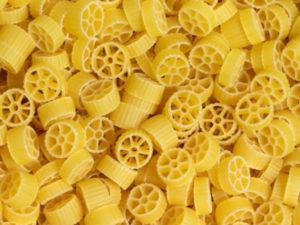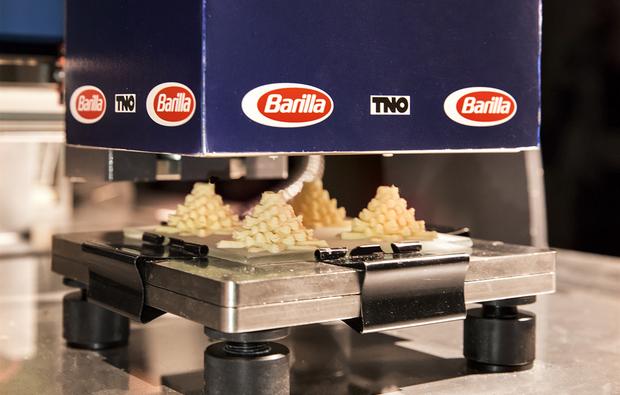Is there a food that’s more fun than pasta? I can’t think of one that has more variety in terms of shapes, anyway. Long, thin spaghetti noodles, bow tie pasta, shells, rotini spirals – not only are the multitudes of pasta shapes fun, they’re each crafted to interact with sauces in different ways for varied flavors and textures. Then there are the shapes designed specifically for kids, of course – I remember how excited I used to get about dinosaur-shaped macaroni or alphabet noodles as opposed to plain old boring spaghetti.
All of those classic pasta shapes pale in comparison to what can be created with a 3D printer, however. Pasta company Barilla is a pioneer of 3D printed pasta, having introduced the concept back in 2014 with a contest to design printable pasta shapes. The winners demonstrated the power of 3D printing to create complex, even dynamic shapes that would be impossible to produce any other way, and while it’ll still be a bit of time before such creations appear on grocery store shelves, Barilla is continuing to work hard on prototyping their pasta printer, which they’ve been developing for about five years.
The multinational pasta producer began developing the printer as part of a collaboration with the Netherlands Organisation for Applied Scientific Research (TNO), and they now have a working prototype that they recently presented at Cibus, an Italian food held in Parma, Italy in May of this year. It’s not fully production-ready yet; Barilla is still working on getting it to print faster but it’s come a long way since the beginning.
“When the project was first launched, the time needed to make the pasta was much longer – it was 20 minutes to print one piece of pasta and today we can print four pieces in about two minutes,” Fabrizio Cassotta, R&D research manager for meal solutions at Barilla, told just-food. “We are now working to improve the time to print; our target is to print one full plate of pasta in two minutes.”
That’s a lot quicker than the time it takes to make a plate of pasta in the traditional manner, although the ingredients are the same – durum wheat semolina and water, loaded into cartridges like a sort of dough-filament. Barilla is starting to experiment with other ingredients as well, and envisions a consumer 3D printer that will allow users to create pasta with their own ingredients, in addition to designing their own shapes on a computer. Right now, the company is working on printable gluten-free, whole grain and vegetable pastas.
“All of these experiences will help us better understand the limits of personalisation because there will probably be some limits,” continued Cassota. “We cannot forget that 3D printing technology is still very new and we are the first company in the world to print 3D pasta prototypes. So it has been a real challenge to transform the standard 3D printing technology and apply it to pasta making.”
In addition to marketing the printer for home use, Barilla is also looking at putting it in restaurants where customers would be able to order their own customized plates of pasta from a phone or tablet. According to Luca Di Leo, Barilla’s head of global media relations, the company currently owns four restaurants in the United States, and they’re planning to open more. Those restaurants could be good venues for testing the printer once it’s finally ready for commercial use, he said – but that’s still a ways off.
“What’s important to stress is that this is a medium-to-long-term project,” Di Leo told just-food. “We are still at a very early stage and we are experimenting a lot and so it’s not something that we are ready to turn into a business application in a few months.”
No matter what they end up doing with the printer, however, Barilla maintains that 3D printed pasta will not replace traditional pasta – it’ll be more of a specialty application. Standard pasta-making techniques are still much faster than 3D printed pasta, no matter how speedy they make the printer – according to Cassota, a normal production line can produce up to nine thousand kilos of pasta per hour, while their printer can currently produce about four kilos per day.
Still, the idea of 3D printed pasta is appealing, especially because it can produce otherwise-impossible shapes. Everyone loves customization, and while 3D printed pasta may seem like a novelty, it will likely have staying power as a specialty food – because who doesn’t love fancy pasta shapes? Discuss in the Pasta 3D Printer forum over at 3DPB.com.
[Source: just-food / Images: Spadellatissima.com]Subscribe to Our Email Newsletter
Stay up-to-date on all the latest news from the 3D printing industry and receive information and offers from third party vendors.
You May Also Like
Further Understanding of 3D Printing Design at ADDITIV Design World
ADDITIV is back once again! This time, the virtual platform for additive manufacturing will be holding the first-ever edition of ADDITIV Design World on May 23rd from 9:00 AM –...
3D Printer Maker EVO-tech Reborn as NEVO3D — Once More With Feeling
EVO-tech was a 3D printing service and original equipment manufacturer established in 2013 and based in Schörfling am Attersee, Austria. The company produced high-quality material extrusion systems featuring linear bearings,...
3D Systems Brings 3D Printed PEEK Cranial Implant to the U.S. with FDA Clearance
For more than 10 years, 3D Systems (NYSE:DDD) has worked hand-in-hand with surgeons to plan over 150,000 patient-specific cases, and develop more than two million instruments and implants from its...
CDFAM Returns to Berlin for Second Annual Symposium
The second CDFAM Computational Design Symposium is scheduled for May 7-8, 2024, in Berlin, and will convene leading experts in computational design across all scales. Building upon the first event...


































